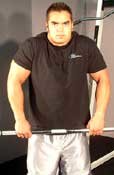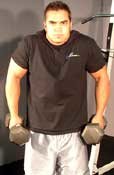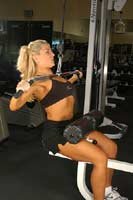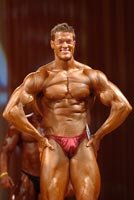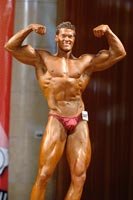Everyone should consider varying their exercise routines for two fundamental reasons:
- To prevent or delay reaching a plateau in workout performance, shocking the body into further development and
- To prevent boredom associated with doing the same regimen workout after workout, week after week.
Adding variety to an exercise program can improve adherence and can also help you stay physically challenged and mentally stimulated. The body will most likely adapt to a repetitive training stimulus within approximately four to eight weeks. Modifying your exercise routine will help avoid a plateau.
There are several ways you can spice up your current routine in order to stay enthusiastic and excited about your workouts. You can boost the intensity of your workouts by implementing the intensity principles outlined previously in this book. You can vary the exercises themselves, the order in which you do them, rest periods, rep ranges and rep tempo.

Substituting Exercises:
The exercises themselves can be substituted for; some exercises that are fairly similar can feel very different. The military press, for instance, using dumbbells feels completely different than using a barbell. It puts different demands on your deltoids, having to coordinate and balance two weights in your hands as opposed to one. Same goes for any other type of press, shrugs, deadlifts or lunges. Switch to dumbbells for a while to give your muscles a new challenge.
Targetting Muscle Groups:
Not only can you substitute exercises from barbell to dumbbell, but you can also target the same specific muscle group by using cables or machines. Lat pulldowns in place of chin-ups, cable side laterals for dumbbell laterals, smith-machine squats for barbell squats, and leg press toes raises for standing calf raises to name a few.
Know what muscles you want to target and then try variations of exercises for them. If you want to hit the lower pectorals and have been doing decline presses for a while, give weighted dips a try for a while. Certain movements are so fundamental, like the bench press that they have to be included in any complete exercise program. But by exploring a range of different exercises, you will be able to find the ones that suit you best and get the most out of.
The "Muscle Confusing" Technique:
I change the order in which I do my exercises on a continual basis; this is called the "muscle confusing" technique. There are numerous ways to rearrange the order of your exercises while providing a quality workout. The change does not have to be drastic in order to stimulate continuous muscle growth. Simply flop the order of any two exercises the next time you train.
| FORUM THREAD | ||
|

Pre-Exhaust Effect:
You can also arrange exercises to provide a pre-exhaust effect. Doing dumbbell flyes, for example, before performing bench presses. Changing the sequence of the exercises will keep your body guessing and help in preventing a plateau. Still giving you enough structure to keep your workouts productive and progressive.
Rep Speed Manipulation:
Another way of varying your workout is to manipulate the rep speed. This will allow you to target different muscle fibers. There are three types of muscle fibers, classified according to their contractile speed and metabolic characteristics. Type I are red in color and considered to be slow-twitch. These fibers are highly oxidative and used primarily for endurance. Type IIa and IIX are white, glycolytic and are considered to be fast-twitch.
Fast-twitch fibers are bigger than slow-twitch by about 20 percent. They have the greatest growth potential and are recruited for strength and power. If you train quick and explosive, you activate more of these fast-twitch fibers. An advantage of high-speed reps is that you can use heavier poundage, increasing the overload. You can also do more work in less time, serving to burn body fat.
Training at a slower tempo has several advantages. For one, you eliminate any cheating or body momentum, this ensures pure muscle action. Another is that it decreases the risk of injury by having to control the movement more. Finally, lifting the weight slower than normal will have your muscles screaming for mercy - a great way to raise the intensity level. Try a three second down and three second up pace to stimulate your muscles differently.
Varying your rep ranges also impact which muscle fibers you work to a large degree. Training with higher repetitions (15-20) will stimulate the slow-twitch fibers more. Conversely, working in the lower rep ranges (4-8) will stimulate the fast-twitch fibers more. Some muscles respond best to a particular rep range due to their muscle fiber inheritance.
The abdominals, forearms and calves are predominately made up of slow-twitch fibers. They are best off being trained in the higher rep ranges. However, switching the rep ranges up for other muscle groups is advantageous in breaking plateaus. Periodization is one way of doing this.
Forum Threads:
- Bench Press Program Stuck At Plateau. - Started By tso
"I have been stuck on a bench press plateau for over a year. I maxed at 225 in August of 06 and then at 230 in July of 07. Then I was back at 225 in oct."
- Squat Plateau. - Started By rainman777
"My squat has been stuck recently. What are some ways to break this and start steadily gaining again. Sometime beside rep changes. thx."
- I Plateau On 5x5. - Started By bballusa
"So, I basically figured that once i reached my original 5rm on 5x5 (intermediate), then I would begin a hypertrophy program. After a copule months of this, I would start another strength program up (probably 5x5), this time able to beat my maxes again."

Training Split:
Changing your training split up every 4-8 weeks can prevent muscle growth stagnation. Each training week is called a microcycle. The back, chest, legs, and shoulders are staples and biceps, triceps, calves, forearms, traps and abs can all be switched around. Even a subtle change in the routine after four microcycles can prevent a plateau.
| RELATED ARTICLE | ||
|

Rest Periods:
Decreasing or increasing your rest periods between sets can greatly impact your workout. If you normally take three minutes to rest between sets, try decreasing it to one and a half minutes. Taking short and long rest periods have different advantages.
It depends on what you are trying to accomplish and it goes with the concept of periodization. Shorter rest periods will keep your heart rate elevated; this increases the oxidation of body fat.
Periodization
Periodization prevents overtraining and provides the muscles with the best biological environment for muscle growth and increasing strength. It can reduce injury and help keep you motivated during your workouts.
Training with high intensities and overload year round is tough on the body - the central nervous system, muscles, connective tissue, joints and tendons can only take so much. Even top professional athletes cycle their training to reduce the risk of overtraining and ensure long-term gains.
You start to get mentally and physically drained after about 8-10 weeks, which is a mesocycle, and it is a good idea to ease up a week or two. You can even plan to take an entire week off after training for one mesocycle and do what is called active rest. No resistance training is done during the week, yet you're not a couch potato either. You can still go on hikes and be active outside while resting your muscles.
Everyone responds differently to training and you need to learn your optimal all-out training time before you cut back and give your body a rest. The same goes for each training day or unit.
Let's say you planned a high rep day at the gym and walk in feeling really strong and want to train heavy. Are you going to let an opportunity to train heavy pass you by because you are supposed to train light? Or what if you planned a heavy day, but you feel weak from not getting enough sleep from the night before.
Are you going to risk injury by going ahead and training heavy? Train you body instinctively, you can't treat it like a machine. You will know when you can train full throttle, with 100 percent intensity and when to back off just to maintain.

Periodization Training Cycles
Periodization can employ several types of training cycles throughout the year.
Power:
You can train for power and perform 3-6 reps with the heaviest weight you can handle with good form. The reps should be done as quickly and explosively as possible. It also involves taking longer rest periods between sets, anywhere from 3-5 minutes. It ensures full recovery between sets.
This method is good for recruiting fast-twitch muscle fibers and more nerve motor units. This results in increased strength and is generally practiced by powerlifters, sprinters and football players.
Muscle Hypertrophy:
A rep scheme of 8-12 reps and shorter rest periods is optimal for muscle hypertrophy (growth in size). Shorter rest periods can increase growth hormone levels. They also increase blood lactate levels during exercise, forcing your body to improve its ability to buffer the accumulating lactate. This helps in sustaining sub-maximal and maximal contractions over a given time period.
Targetting Slow-Twitch Muscle Fibers:
Higher rep ranges, 15-20 reps, target more of the slow-twitch muscle fibers. Training in a higher rep range gives the body a break from the heavier weights. It increases the mitochondrial content of the muscle, which improves localized muscle endurance. Endurance can be a limiting factor of growth.
| RELATED ARTICLE | ||
|
Conclusion
Apply different rep ranges and rest periods throughout the year. Listen to your body and know when it is time to make a change - even if it is for just one day. When you become overtrained, you feel irritable, fatigued, uptight, and anxious. You can actually lose your sense of humor and enthusiasm for your workouts.
Overtraining is counterproductive to building muscle. It is important to cycle your training through periodization to prevent this from happening.

